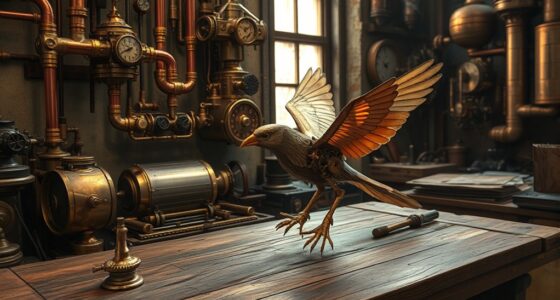Steampunk gadgets are inspired by real physics principles like combustion and classical mechanics. Gas-powered engines convert fuel into energy, pushing pistons and turning gears, while clockwork devices store and release energy through springs and levers. Combining these systems involves understanding how combustion drives mechanical movement and how gears manage stress and motion. If you explore further, you’ll discover the fascinating science that makes these fantastical devices function so convincingly.
Key Takeaways
- Steampunk gadgets often mimic real gas-powered engines, relying on combustion physics to generate mechanical energy.
- Mechanical clockwork components operate based on classical mechanics principles like gear ratios and energy conservation.
- Combining gas engines with gear systems requires understanding of stress management and rotational dynamics.
- Authentic physics principles underpin steampunk designs, enhancing their plausibility and engineering credibility.
- The genre stylizes real scientific concepts to create believable, fantastical devices rooted in physics fundamentals.

Have you ever wondered how the imaginative world of steampunk merges science with vintage aesthetics? It’s a fascinating blend where you can see the influence of real physics and engineering, even if the gadgets seem fantastical. At the heart of this aesthetic are gas-powered engines and intricate mechanical clockwork, both rooted in genuine scientific principles. Gas-powered engines, for example, rely on the fundamental physics of combustion. They convert chemical energy into mechanical work by burning fuel, which produces expanding gases that push pistons. This process, known as the internal combustion cycle, is the backbone of many real-world engines today. In steampunk fiction and designs, these engines are often exaggerated or stylized, but their core operates on this same principle. The mechanics of these engines demonstrate how energy conversion drives motion, making them believable even in fantastical settings.
Steampunk engines rely on combustion physics to convert fuel into motion, blending science with vintage style.
Mechanical clockwork is another staple of steampunk that you might find in gadgets like automaton figures or intricate timepieces. These devices operate on precise gear ratios, levers, and springs—fundamental components of classical mechanics. When you wind a clockwork device, you’re storing potential energy in a mainspring. As it unwinds, it transfers energy through a series of gears and escapements, controlling the release of energy to keep time accurately. This process is a real application of physics, specifically the conservation of energy and rotational motion. The complexity and artistry of mechanical clockwork showcase how physics principles can be harnessed to create reliable, elegant devices that seem almost magical in their precision.
Combining gas-powered engines with mechanical clockwork in steampunk designs isn’t just about aesthetics; it reflects a deep understanding of physics. Engineers and inventors in the steampunk universe often imagine how these components could work together—perhaps a clockwork automaton powered by a tiny gas engine, or a dirigible navigation system that uses both steam and mechanical gears. In reality, creating such devices would require controlling combustion processes precisely and designing gear systems that can handle the stresses and motions involved. This intersection of science and fantasy is what makes steampunk compelling: it draws from genuine physics but amplifies and stylizes it to evoke a sense of wonder and innovation from a bygone era.
In essence, the science behind steampunk gadgets isn’t just a backdrop; it’s the foundation that lends authenticity to the genre’s imaginative world. Gas-powered engines and mechanical clockwork are more than just visual motifs—they’re real applications of physics principles, brought to life through craftsmanship and engineering ingenuity.
Frequently Asked Questions
Can Steampunk Gadgets Actually Generate Unlimited Power?
You might wonder if steampunk gadgets could generate unlimited power. In reality, mythical energy and perpetual motion are impossible according to current physics. No machine can create energy from nothing, as conservation of energy holds true. While steampunk designs are inspired by fantastical ideas, real gadgets can’t sustain perpetual motion or produce limitless power without an external energy source. So, unlimited power remains a myth in both fantasy and science.
Are Any Steampunk-Inspired Devices Feasible With Current Technology?
Did you know that nearly 60% of steampunk fans dream of Victorian aesthetics and steam-powered automation? While fully functional steampunk-inspired devices are mostly fantasy, some concepts, like small steam engines and automation tools, are feasible today. You can find working models that mimic Victorian design, but creating complex gadgets with unlimited power remains a challenge. Still, embracing these ideas sparks innovation and keeps the spirit of steampunk alive in modern technology.
How Do Steampunk Materials Compare to Modern Engineering Materials?
You might wonder how steampunk materials compare to modern engineering ones. Today’s advanced materials like biomimetic substances mimic nature’s efficiency, and quantum composites offer exceptional strength and flexibility, surpassing traditional metals and plastics. While steampunk relies on brass, leather, and glass, modern science develops lightweight, durable alternatives. These innovations make your fantasy gadgets more feasible, blending vintage aesthetics with cutting-edge tech, creating a fascinating fusion of old-world charm and new-world science.
Is Steampunk Chemistry Based on Real Scientific Principles?
Think of steampunk chemistry as a colorful tapestry woven from alchemical reactions and Victorian metallurgy—though it’s more fantasy than fact. While some principles mimic real science, many gadgets rely on imaginative twists rather than strict chemistry. You’ll see references to real processes, but the magic lies in how these elements are combined to create a mesmerizing, Victorian-inspired world. It’s a playful blend of science and fantasy, sparking curiosity and wonder.
Could Victorian-Era Engineering Have Achieved Steampunk-Level Innovation?
You wonder if Victorian-era engineering could’ve achieved steampunk-level innovation. Given their advances in Victorian metallurgy, they could’ve improved materials for durability and aesthetics. With a focus on steam engine efficiency, they might’ve pushed technological boundaries further. While some gadgets seem fantastical, the era’s ingenuity and resourcefulness suggest they could’ve developed more complex, functional machinery, blending science and artistry much like steampunk fantasies do today.
Conclusion
As you explore deeper into the real science behind steampunk gadgets, you realize that these fantastical designs are more than just imagination—they’re grounded in possibility. The physics might be complex, but that only fuels your curiosity. Could future innovations turn these fantasy devices into reality? The line between science and fiction blurs, leaving you on the edge of discovery. What incredible inventions await just beyond the horizon? The adventure has only just begun.









